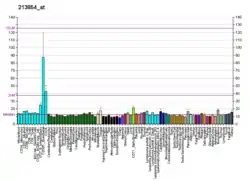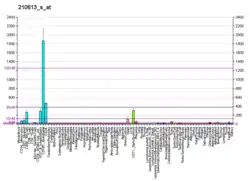SYNGR1
Synaptogyrin-1 is a protein that in humans is encoded by the SYNGR1 gene.[5][6][7]
This gene encodes an integral membrane protein associated with presynaptic vesicles in neuronal cells. The exact function of this protein is unclear, but studies of a similar murine protein suggest that it functions in synaptic plasticity without being required for synaptic transmission. The gene product belongs to the synaptogyrin gene family. Three alternatively spliced variants encoding three different isoforms have been identified.[7]
References
- GRCh38: Ensembl release 89: ENSG00000100321 - Ensembl, May 2017
- GRCm38: Ensembl release 89: ENSMUSG00000022415 - Ensembl, May 2017
- "Human PubMed Reference:". National Center for Biotechnology Information, U.S. National Library of Medicine.
- "Mouse PubMed Reference:". National Center for Biotechnology Information, U.S. National Library of Medicine.
- Kedra D, Pan HQ, Seroussi E, Fransson I, Guilbaud C, Collins JE, Dunham I, Blennow E, Roe BA, Piehl F, Dumanski JP (Oct 1998). "Characterization of the human synaptogyrin gene family". Hum Genet. 103 (2): 131–41. doi:10.1007/s004390050795. PMID 9760194.
- Janz R, Sudhof TC, Hammer RE, Unni V, Siegelbaum SA, Bolshakov VY (Jan 2000). "Essential roles in synaptic plasticity for synaptogyrin I and synaptophysin I". Neuron. 24 (3): 687–700. doi:10.1016/S0896-6273(00)81122-8. PMID 10595519.
- "Entrez Gene: SYNGR1 synaptogyrin 1".
Further reading
- Dunham I, Shimizu N, Roe BA, et al. (1999). "The DNA sequence of human chromosome 22". Nature. 402 (6761): 489–95. Bibcode:1999Natur.402..489D. doi:10.1038/990031. PMID 10591208.
- Mirnics K, Middleton FA, Marquez A, et al. (2000). "Molecular characterization of schizophrenia viewed by microarray analysis of gene expression in prefrontal cortex". Neuron. 28 (1): 53–67. doi:10.1016/S0896-6273(00)00085-4. PMID 11086983.
- Strausberg RL, Feingold EA, Grouse LH, et al. (2003). "Generation and initial analysis of more than 15,000 full-length human and mouse cDNA sequences". Proc. Natl. Acad. Sci. U.S.A. 99 (26): 16899–903. Bibcode:2002PNAS...9916899M. doi:10.1073/pnas.242603899. PMC 139241. PMID 12477932.
- Verma R, Chauhan C, Saleem Q, et al. (2004). "A nonsense mutation in the synaptogyrin 1 gene in a family with schizophrenia". Biol. Psychiatry. 55 (2): 196–9. doi:10.1016/j.biopsych.2003.10.012. PMID 14732601.
- Collins JE, Wright CL, Edwards CA, et al. (2005). "A genome annotation-driven approach to cloning the human ORFeome". Genome Biol. 5 (10): R84. doi:10.1186/gb-2004-5-10-r84. PMC 545604. PMID 15461802.
- Gerhard DS, Wagner L, Feingold EA, et al. (2004). "The Status, Quality, and Expansion of the NIH Full-Length cDNA Project: The Mammalian Gene Collection (MGC)". Genome Res. 14 (10B): 2121–7. doi:10.1101/gr.2596504. PMC 528928. PMID 15489334.
- Verma R, Kubendran S, Das SK, et al. (2006). "SYNGR1 is associated with schizophrenia and bipolar disorder in southern India". J. Hum. Genet. 50 (12): 635–40. doi:10.1007/s10038-005-0307-z. PMID 16215643.
- Kimura K, Wakamatsu A, Suzuki Y, et al. (2006). "Diversification of transcriptional modulation: Large-scale identification and characterization of putative alternative promoters of human genes". Genome Res. 16 (1): 55–65. doi:10.1101/gr.4039406. PMC 1356129. PMID 16344560.
- Cheng MC, Chen CH (2007). "Identification of rare mutations of synaptogyrin 1 gene in patients with schizophrenia". Journal of Psychiatric Research. 41 (12): 1027–31. doi:10.1016/j.jpsychires.2006.08.010. PMID 17049558.
- Chi A, Valencia JC, Hu ZZ, et al. (2007). "Proteomic and bioinformatic characterization of the biogenesis and function of melanosomes". J. Proteome Res. 5 (11): 3135–44. doi:10.1021/pr060363j. PMID 17081065.
This article is issued from Wikipedia. The text is licensed under Creative Commons - Attribution - Sharealike. Additional terms may apply for the media files.






